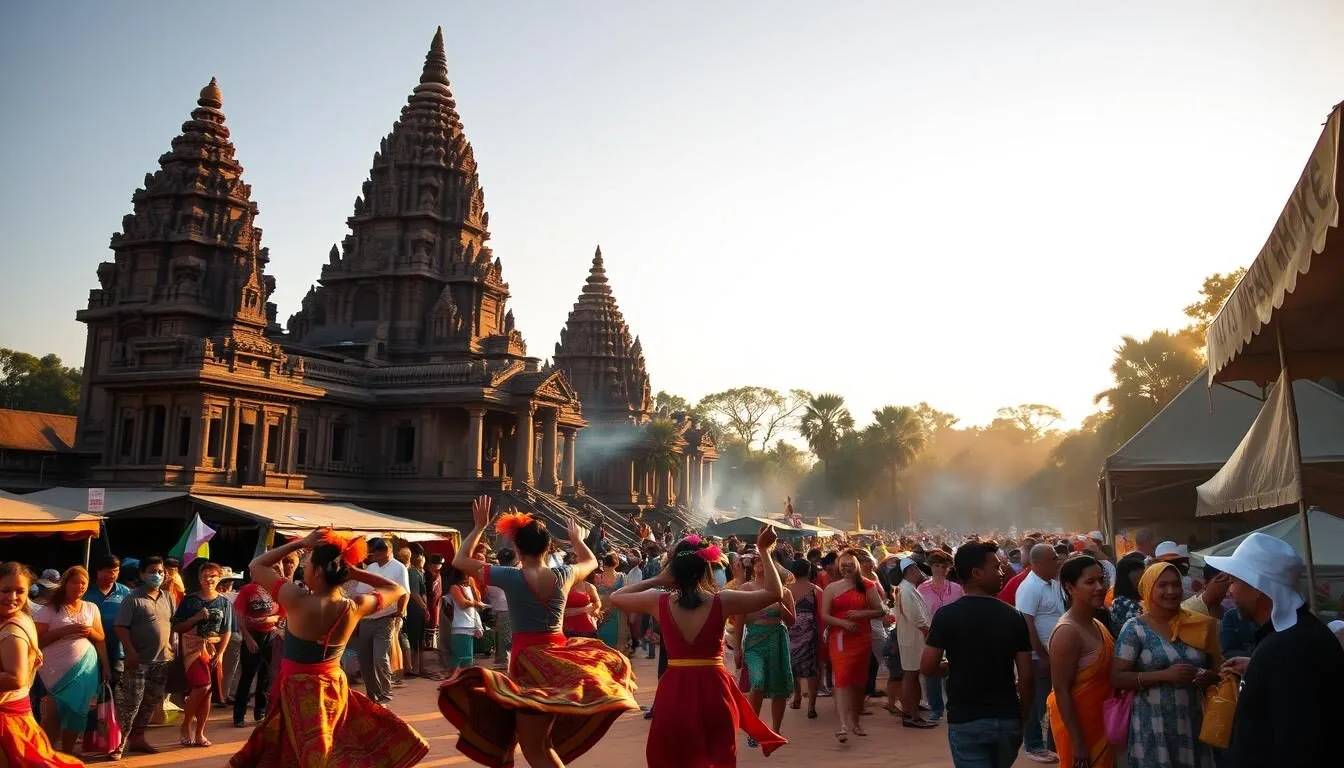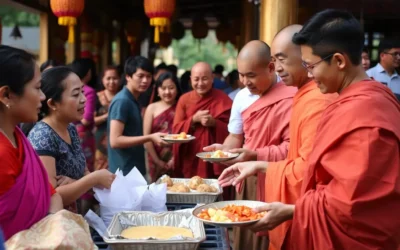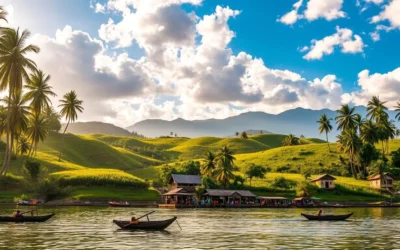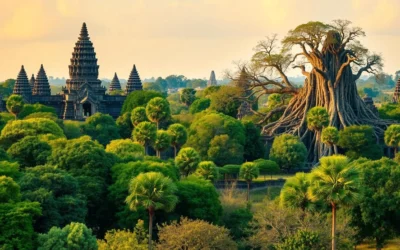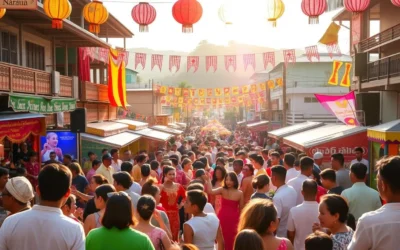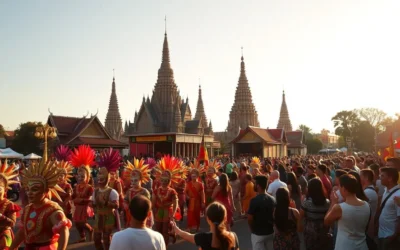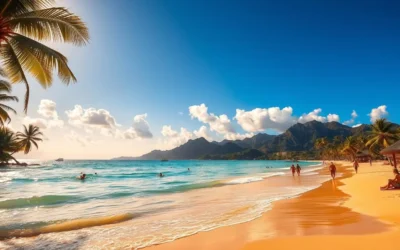✓ Accommodations✓ Flights✓ Rental Cars✓ Tours & Activities
Did you know that Cambodia is home to some of the most vibrant and culturally rich festivals in Southeast Asia? When you visit Angkor, you’re not just exploring ancient temples; you’re immersing yourself in a world of colorful celebrations and deep-rooted traditions.
These events offer a unique experience, allowing you to connect with locals and gain insights into Cambodian culture. From joyous New Year celebrations to solemn ancestral commemorations, each festival provides a distinct perspective on Cambodian life and spirituality.
By timing your visit to coincide with these events, you’ll enhance your travel experience and create unforgettable memories.
The Cultural Significance of Festivals in Cambodia
The vibrant festivals in Cambodia offer a unique insight into the nation’s complex cultural landscape. Cambodian festivals are deeply intertwined with the country’s history, culture, and traditions. Most celebrations follow the Khmer lunar cycle, drawing inspiration from Buddhism, Hinduism, and old royal customs.
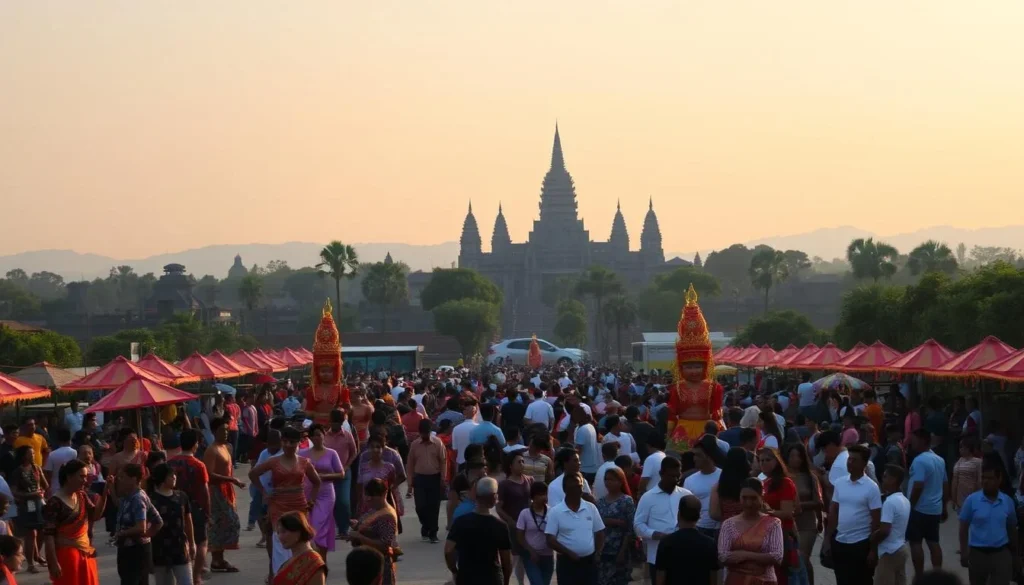
The significance of these festivals can be understood through their connection to Buddhism and ancient history.
The Role of Buddhism in Cambodian Celebrations
Buddhism plays a central role in Cambodian celebrations, with many festivals revolving around important Buddhist holy days. Theravada Buddhist rituals form the foundation of many festivals, with monks leading ceremonies and temple activities being central to the events. This blend of religious devotion and community celebration strengthens social bonds while honoring traditions.
How Festivals Connect to Cambodia’s Ancient History
The festivals connect directly to Cambodia’s ancient history, particularly the Angkor period. Many celebrations maintain traditions that date back to the height of the Khmer Empire. The temples of Angkor often serve as dramatic backdrops for festival celebrations, connecting present-day events to the architectural and spiritual achievements of Cambodia’s past.
Why Experiencing Local Festivals Enhances Your Visit
When you time your trip to coincide with local festivals, you’ll discover a more authentic Cambodia. Experiencing these festivals firsthand allows you to immerse yourself in the local culture, creating memories that will last a lifetime.
Immersing in Local Culture
By participating in Cambodia’s vibrant festivals, you’ll gain a deeper understanding of the country’s history, values, and traditions. You’ll experience Cambodia beyond the typical tourist attractions, gaining authentic insights into how locals celebrate their cultural heritage. The festive atmosphere during these events creates a special energy around the Angkor complex, giving you a different perspective on these ancient monuments.
You’ll find that festival times transform the Angkor region, with temples and public spaces taking on new significance as they become venues for traditional ceremonies and celebrations. This transformation offers unique photo opportunities, cultural performances, and food experiences that enhance your overall trip to Cambodia.
Best Viewing Spots Around Angkor for Festival Celebrations
The best viewing spots around Angkor for festival celebrations include the Western Baray for water festivals, Angkor Wat’s main courtyard for royal ceremonies, and smaller temples like Banteay Srei for more intimate Buddhist observances. Here’s a guide to some of the top locations:
| Location | Festival Type | Experience |
|---|---|---|
| Western Baray | Water Festival | Boat racing and water ceremonies |
| Angkor Wat’s Main Courtyard | Royal Ceremonies | Traditional royal performances |
| Banteay Srei | Buddhist Observances | Intimate Buddhist ceremonies |
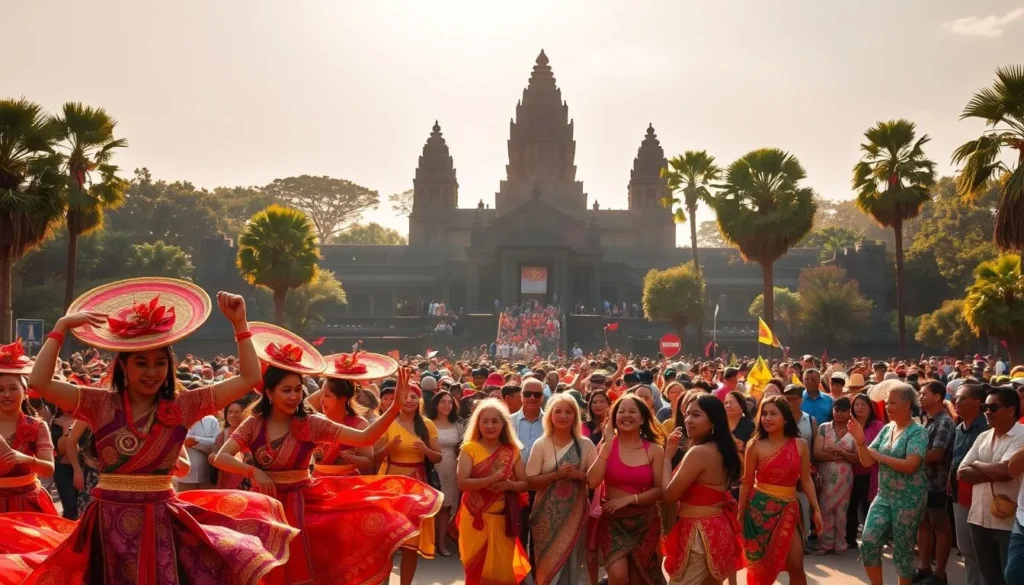
With a local guide, you can gain a deeper understanding of the significance of different events and rituals, making your experience more meaningful and educational. By witnessing these celebrations, you’ll gain context for the historical sites you’re visiting, seeing how ancient traditions continue to influence contemporary Cambodian culture.
Khmer New Year: Cambodia’s Most Celebrated Festival
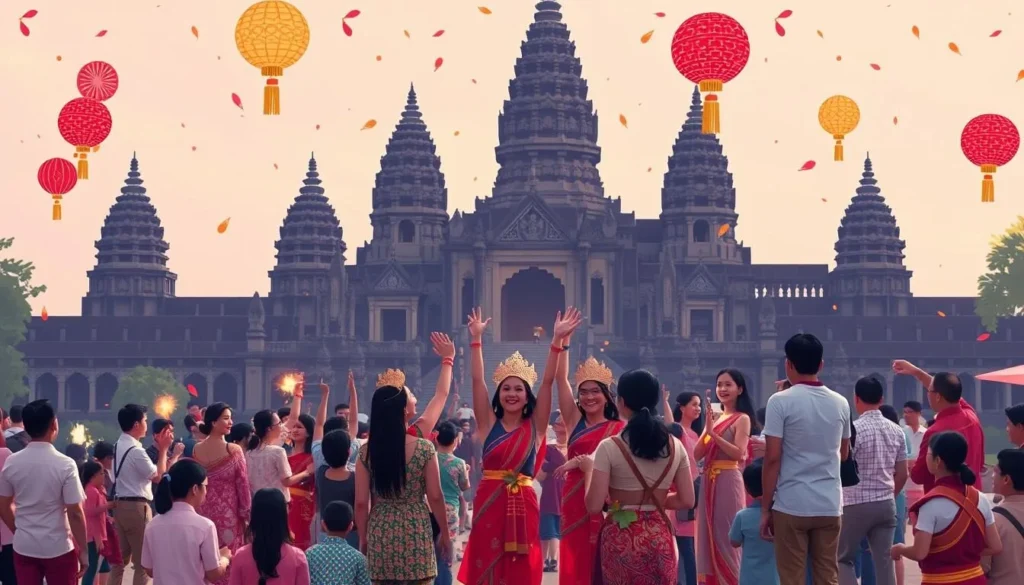
Cambodia’s most celebrated festival, Khmer New Year, is a time-honored tradition that symbolizes renewal and purification. This significant festival marks the end of the harvest season and the beginning of the rainy season, typically celebrated on April 13th or 14th.
The three-day celebration is a time for relaxation, family reunions, and cultural and religious festivities. During this period, Cambodians engage in various traditional activities, including cleaning their homes, visiting temples, and participating in games like Bos Angkunh (tug-of-war) and Chol Chhoung (ball-throwing).
Traditional Activities During Khmer New Year
During Khmer New Year, you’ll participate in traditional New Year activities like water blessings at temples, where monks sprinkle water on devotees to symbolize purification and renewal. Families visit temples to make offerings, build sand stupas, and participate in traditional games that have been played during Khmer New celebrations for generations.
Many Cambodians wear new clothes, clean their homes, and prepare special dishes to mark the transition to the new year. Water fights and playful sprinkling are common during this period, so be prepared to get wet if you’re visiting during Khmer New Year—it’s considered good luck and part of the fun!
Best Places to Experience Khmer New Year in Angkor
The best places to experience Khmer New Year around Angkor include Angkor Wat itself, where special ceremonies take place, and nearby villages where locals welcome visitors to join their family celebrations. You’ll witness traditional music and dance performances throughout the three-day celebration.
This harvest season celebration offers a perfect opportunity to taste traditional Khmer foods and witness cultural performances that aren’t regularly available to tourists. By participating in Khmer New Year, you’ll gain a deeper understanding of Cambodian traditions and create unforgettable memories.
Water Festival: Celebrating Cambodia’s Unique River Phenomenon
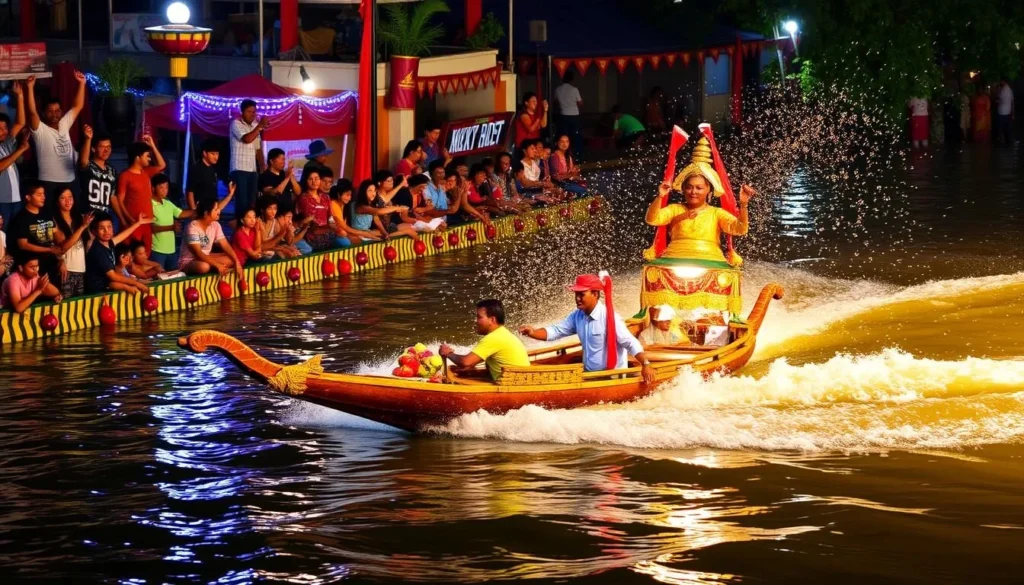
Cambodia’s Water Festival is a unique celebration that honors the country’s remarkable river dynamics. The Water Festival, known as Bon Om Touk, is an annual celebration held in Phnom Penh, typically occurring in November over three days. It commemorates the reversal of the flow between the Mekong and Tonle Sap rivers, a unique natural phenomenon.
This event is not only a celebration but also a way for Cambodians to thank the water god for abundant water and pray for the next harvest. The festival features spectacular boat races, with teams competing on the Tonle Sap River.
Boat Racing Traditions
The boat racing traditions you’ll witness date back to the Angkor period, when they served as naval training exercises for the Khmer Empire’s military forces. During your visit, you’ll see elaborately decorated boats with up to 80 rowers competing in races that represent different villages and regions, showcasing community pride and teamwork.
Experiencing the Water Festival as a Visitor
While the main Water Festival celebrations take place in Phnom Penh, you can experience smaller-scale events around Angkor, particularly at the Western Baray and along waterways near Siem Reap. The festival includes not just boat races but also illuminated boat processions in the evenings, creating magical reflections on the water that make for unforgettable photographs.
You’ll find the atmosphere electric during these days, with food stalls, music, and celebrations continuing well into the night around the Water Festival venues. If you’re visiting during this time, position yourself along the banks of the water early to secure a good viewing spot, as locals and tourists alike gather in large numbers for this popular celebration.
Pchum Ben: Cambodia’s Unique Festival of the Dead
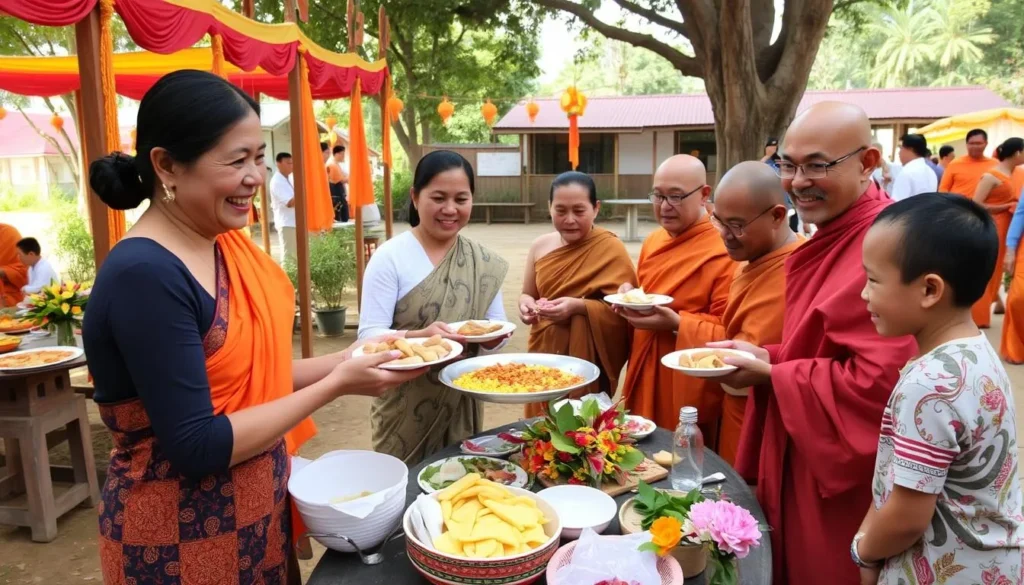
As a visitor to Cambodia, experiencing Pchum Ben can be a profound way to understand the local culture’s reverence for the deceased. Pchum Ben, a 15-day festival culminating on the 15th day of the 10th Khmer month, is a significant celebration where Cambodians honor their ancestors up to seven generations back.
Rituals and Offerings During Pchum Ben
During Pchum Ben, families gather at temples before dawn each day to offer food to monks and make special offerings for their deceased relatives. The preparation of bay ben (balls of sticky rice) is a crucial ritual, believed to be passed on to the spirits, alleviating their suffering.
Participating in Pchum Ben as a Respectful Visitor
As a respectful visitor, you can participate by observing ceremonies at the temples around Angkor, wearing modest clothing, and maintaining a quiet demeanor during the rituals. The final day of Pchum Ben is particularly important, with special ceremonies taking place at major temples where monks chant through the night.
By experiencing Pchum Ben, you’ll gain a unique insight into how Cambodians maintain connections with their ancestors and how Buddhist beliefs influence daily life. This festival provides a meaningful way to engage with the local culture, creating lasting memories of your visit to Cambodia during this significant celebration that lasts for a month and culminates on a special day.
Royal Ceremonies: Ancient Traditions of the Cambodian Monarchy
As you explore the rich cultural heritage of Cambodia, you’ll have the opportunity to witness the majestic royal ceremonies that have been a cornerstone of the monarchy for centuries. These ceremonies are a testament to the country’s rich history and cultural traditions, offering a unique glimpse into the monarchy’s ancient practices.
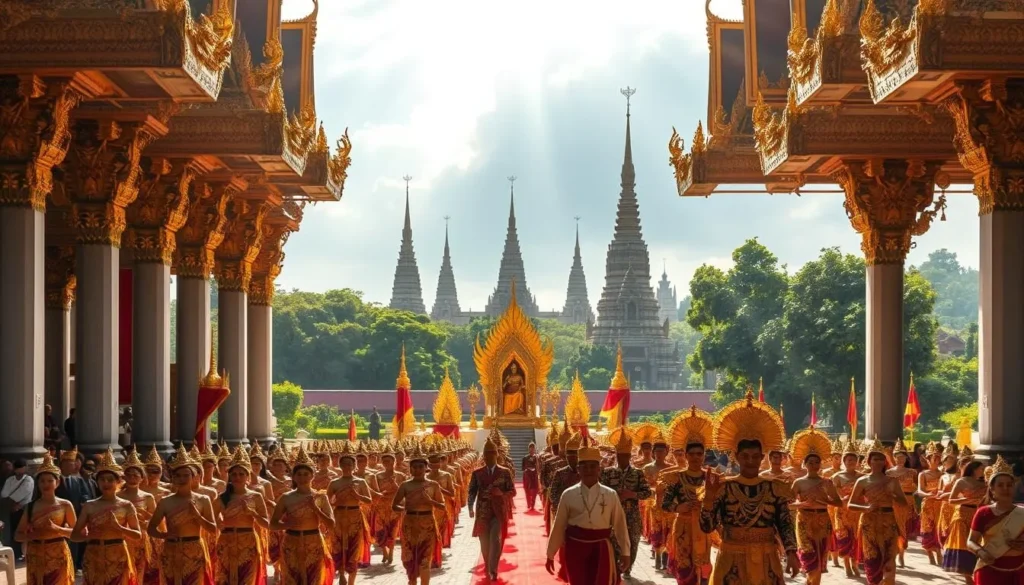
The Royal Ploughing Ceremony’s Agricultural Predictions
The Royal Ploughing Ceremony, also known as Bonn Chroat Preah Nongkoal, is an ancient tradition that marks the beginning of the rice-growing season. During this ceremony, royal representatives perform symbolic plowing, and royal oxen are presented with various foods. Their choices are interpreted as predictions for the coming year’s harvest, connecting Cambodia’s monarchy to its agricultural foundations.
This event offers a rare glimpse into Cambodia’s royal traditions that have continued from the ancient Angkor period into modern life. The ceremony includes traditional music, elaborate costumes, and ritualized movements that have been preserved for centuries.
Royal Celebrations at Angkor’s Historic Sites
If you visit during May, you might see special royal celebrations at Angkor’s historic sites, particularly around Angkor Thom and the Terrace of the Elephants. These celebrations reflect the complex religious history of the Khmer Empire and its evolution over time.
The ceremonial aspects you’ll observe include traditional music and elaborate costumes, highlighting the relationship between royal power, religious authority, and the harvest that sustained the kingdom. By witnessing these ceremonies, you’ll gain insights into how Cambodia’s royal traditions have adapted yet maintained continuity throughout the country’s tumultuous history.
Buddhist Celebrations: Spiritual Festivals in Cambodia
As you explore Cambodia’s rich cultural heritage, you’ll discover that Buddhist celebrations play a vital role in the country’s festival calendar. These spiritual festivals are deeply ingrained in Cambodian culture, offering a unique glimpse into the nation’s traditions and values.
Meak Bochea and Vesak Bochea Observances
Meak Bochea, celebrated on the full moon day of the third lunar month, commemorates Buddha’s sermon to 1,250 enlightened disciples. On this day, monks meditate and pray, while locals offer necessities and participate in candle ceremonies at temples, symbolizing their reverence for the Triple Gem of Buddhism. You’ll witness monks gathering for special ceremonies, creating a serene atmosphere that reflects the core principles of Buddhism.
During Meak Bochea, typically held in February, you’ll see devotees circling the main temple buildings three times in candlelit processions, creating a mesmerizing atmosphere of devotion and reflection. Another significant observance is Vesak Bochea, which celebrates Buddha’s birth, enlightenment, and passing into nirvana, offering you the chance to observe special alms-giving ceremonies where monks receive offerings from the faithful.
Temple Ceremonies and Processions
Temple ceremonies are at the heart of Buddhist festival celebrations. During these events, monks lead meditation sessions and dharma talks, while devotees offer food and other necessities to the monastic community. The evening processions, where participants circle the temple three times with candles, incense, and flowers, are particularly meaningful, representing the core principles of Buddhism. You’ll notice that during these ceremonies, locals bring food offerings to monks, who serve as intermediaries between the physical and spiritual worlds in Cambodian Buddhist practice.
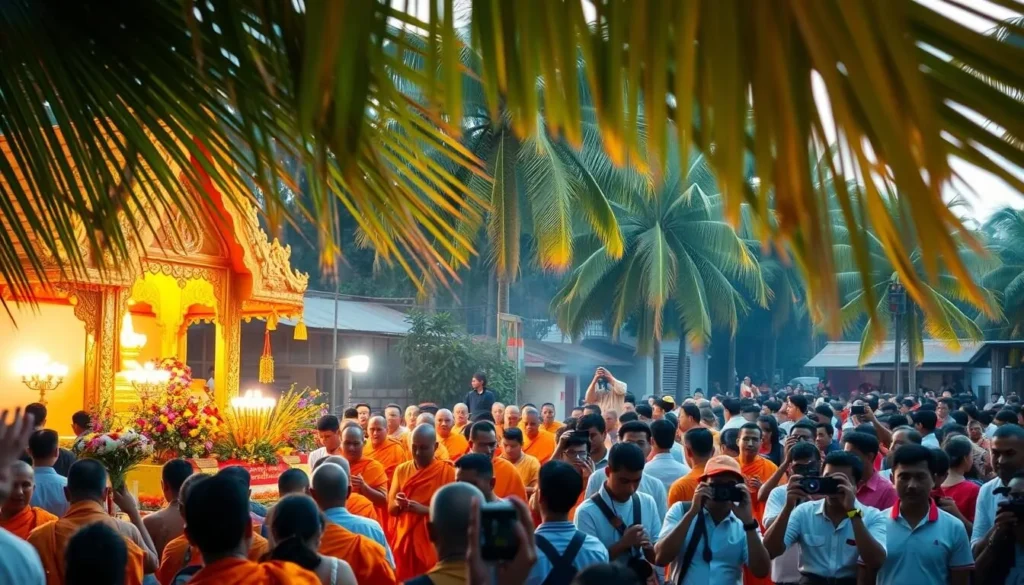
The processions you’ll witness feature devotees carrying candles, incense, and lotus flowers—symbols that represent enlightenment, purification, and the beauty that can emerge from difficult circumstances. These Buddhist celebrations provide you with a peaceful counterpoint to Cambodia’s more boisterous festivals, offering opportunities for quiet observation and spiritual reflection in the magnificent temple settings.
Tips for Attending Cambodian Festivals as a Visitor
Experiencing a Cambodian festival can be a highlight of your trip, but it requires some preparation to fully appreciate the cultural significance. When attending these events, you’ll want to be mindful of local customs and traditions to ensure a respectful and enjoyable experience for both you and the locals.
Cultural Etiquette During Religious Festivals
When visiting temples during religious festivals, it’s crucial to dress modestly and be mindful of your behavior around monks. This includes removing your shoes before entering temple buildings and avoiding physical contact with monks, especially for female visitors. Learning a few basic Khmer phrases, such as greetings and expressions of gratitude, can also go a long way in making your interactions more meaningful.
- Dress modestly with shoulders and knees covered.
- Remove your shoes before entering temple buildings.
- Avoid touching monks, particularly for female visitors.
Planning Your Trip Around Festival Dates
To make the most of your visit, plan your trip around festival dates, as the best time to visit Cambodia for cultural experiences often coincides with major celebrations in Phnom Penh and Siem Reap. Be aware that transportation can be crowded during these times, so book your accommodations and travel arrangements well in advance. Consider splitting your time between main celebrations and smaller local events for a more authentic experience.
- Plan your trip around festival dates to coincide with major celebrations.
- Book accommodations and travel arrangements in advance.
- Consider visiting smaller local events for a more authentic experience.
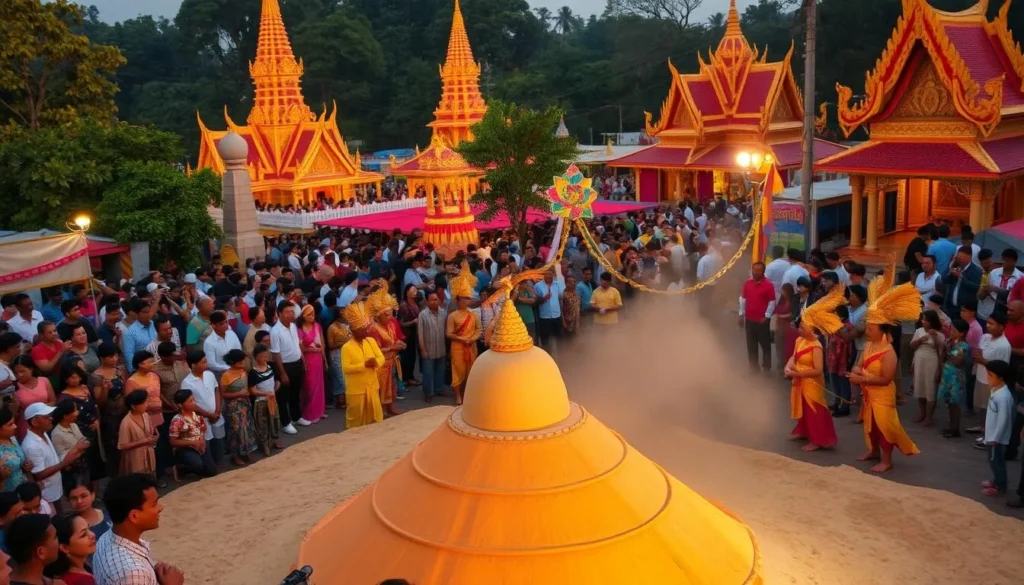
Conclusion
Cambodia’s festivals are a window into the country’s rich history and spiritual practices. By experiencing these vibrant celebrations, you’ll gain a deeper understanding of Cambodian culture and create lasting memories.
Whether you’re drawn to the joyous Khmer New Year or the solemn Pchum Ben, Cambodia’s festivals offer a unique cultural immersion experience. Use this guide to plan your trip around these significant events and connect with the locals on a deeper level.
As you explore the cultural dimensions of Angkor through its festivals, you’ll discover the depth and richness of Cambodian traditions. This experience will add meaning to your travels and provide stories that go beyond typical tourist activities.
The above is subject to change.
Check back often to TRAVEL.COM for the latest travel tips and deals.
